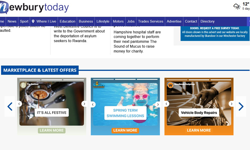As the financial focus of media titles shift from pay-per-copy and subscriptions, tensions between the editorial and commercial team can intensify unless publishers implement ways of working which continue to recognise the contribution of the editorial team in business success. Publishers also need to think beyond just the pecuniary support that advertising must offer. The ads they display to drive revenues to media titles need to work in a way that supports the important work of editorial teams. Advertising should complement and enhance editorial, rather than interrupting and distracting from it, as is far too often the case.
One problem in this area is that conventional ad revenue strategies still primarily focus on monetising the space around content, not the content itself, meaning the focus of value at the media title can get distorted. Yet it is only because most media titles haven’t thrown off the constraints of the old style print era that this method of ad placement is still so prevalent. It’s a mindset which needs to modernise. This is particularly apparent in online publishing. Display advertising placement in major online publications remains surprisingly traditional. Online publishers in particular must properly consider the most valuable asset of their media title – the editorial – and work out how to monetise it. Top quality copy is what draws eyeballs to a publication, but quality has to be paid for. On the internet, media titles successfully operating subscription and pay-per-copy revenue models are in the smallest of minorities, as consumers feel entitled to “free” media. This means there’s few financial metrics that prove how valuable the editorial is, meaning some publishers can overlook its contribution to the bottom line.
Another problem is that the clicks and impressions that are used to measure the performance of online ad campaigns are a metric of the ads around the editorial and do little to evaluate the performance of the actual content. If anything, such clicks may well be a measure of how quickly a consumer can be distracted from the editorial, rather than how much the internet user is compelled to consume the content. What’s worse is that when a campaign that’s run across a media title doesn’t work for a brand, the quality of the editorial can be blamed. No wonder there can be tensions between the ad and editorial departments. Rather, advertising should respect the worth of journalists’ work, as well as consumers’ interest in it, by not trying to immediately divert people elsewhere.
One way online publishers can get around these issues is by a more effective use of hyperlinks. Hyperlinks offer online users more relevant information, improving rather than detracting from the editorial. When a user moves their mouse over and clicks on relevant hyperlinked keywords within an article, it’s because that user is engaged with the content, not distracted by an ad. These mouse actions prove to publishers how effective the editorial is. However the media business can also earn revenue from hyperlinks. The revenue also serves to remind publishers just how crucial quality content is to the performance of their business. Currently, most publishers lack a true metric of revenue contribution from the actual editorial. This can place the content team at a distinct disadvantage to the advertising team in terms of a publisher’s attention. If publishers neglect to place editorial teams on an equal footing with the ad teams, this can lead to performance problems. Consumers visit websites for content, not ads, so the balance of publishers’ focus must be evenly split. Best practice is to construct an ad supported media business which achieves a true partnership between advertising and editorial – and for publishers, that means being able to accurately measure how each side of their media title is contributing to business success. Publishers need to encourage ad teams to take an active interest in what the editorial teams are doing, and vice versa. It can be a big shift in mindset at some media titles, but the benefits of the two sides achieving the same goals of quality content at a profitable title – not just “working towards” those goals – are clear.
Finally, editorial teams’ integrity is paramount to quality content and advertising must respect this. It’s generally inappropriate for hard hitting editorial or a journalist’s article about a sensitive issue to include ads. That means editorial needs a say in whether ads should run on an article or not. At least for in-content advertising, the technology is there to enable publishers to simply turn ads off particular articles or parts of their site where advertising wouldn’t be appropriate. Ads must never corrupt the content. Journalists have too important a job to do. Publishers need to display ads that work for editorial to support quality content that consumers want. That’s the only way ad campaigns will keep performing, the media title will continue to generate revenue, and society will still benefit from impartial and engaging editorial.












